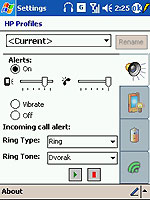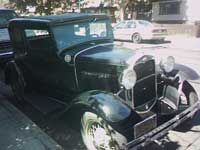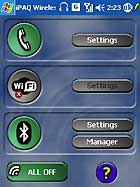| PDA | Phone | Notebooks | Gaming | Accessories | Software | Shop | Discussion |
|
PDA reviews, phone reviews, Tablet PC reviews, game reviews and more! Smartphone & PDA Phone Reviews
Advertisement
|
HP iPAQ 6315 Pocket PC Phone Editor's rating (1-5): Posted Sept. 12, 2004 by Lisa Gade, Editor
in Chief Camera The iPAQ 6315 has an integrated VGA camera and HP will offer a camera-less version for those whose workplace forbids cameras. Like all VGA camera phones, it's great for capturing impromptu shots, but won't replace your dedicated digital camera. As cameras go, it narrowly beats the Samsung i700, Treo 600 and XDA II cameras for sharpness and exposure balance. The lens is located on the back of the phone and doesn't swivel, so you'll need to move the phone around to frame your shot. To take a photo, press the camera button on the unit's right side or launch the camera app from the Start Menu. The entire screen becomes your viewfinder, and it's in landscape orientation. The viewfinder has a large shutter button (you can also press the camera button on the unit's side to take a photo), a help button, settings button and digital zoom buttons. You can leave the camera on automatic exposure, or choose from several settings, set color mode, compression (image quality) and size (640 x 480, 320 x 240 and 160 x 120). The camera has a self timer, shutter sound (you can turn it off) and you can set how long the review window stays open after you take a shot. The sample photos below were taken at 640 x 480 at the highest quality image setting. Click on a photo to see the full size, unedited original photo.
After shooting a photo, you can send it via MMS or email using Pocket Outlook (aka Inbox)-- just tap on the mail button and select the method you prefer. The integration MMS into Outlook makes sending photos a breeze and is much slicker than other Pocket PC phones which use separate applications for MMS. Of course, the camera app integrates well with HP Image Zone, so you can save your photos and view or send them via a variety of means later. |
|
Bundled Software The iPAQ runs Windows Mobile 2003 Phone Edition and includes the standard Pocket Word, Pocket Excel, Pocket Windows Media Player, Outlook, Pictures, Terminal Services and MSN Messenger in ROM. HP adds their backup up (it's really the excellent Sprite Backup) which can backup data to an SD card or backup PIM data to a card or the File Store, HP Image Zone, an image viewer and editor, iPAQ Wireless for managing wireless connections, and HP Profiles. HP Profiles greatly extends the concept of mobile phone profiles that allow you to set ring volume based on locations such as home, meeting and etcetera. You can create profiles that will set a ringtone, ringtone volume, vibration, screen brightness, wireless radio settings and power off settings. So you can have a work setting that turns on WiFi, phone, has brightness set to 40%, and uses a staid ringer. Then you can create a home setting that turns off WiFi but turns on Bluetooth, sets the brightness to 75% and uses an amusing ring tone. You can also set profiles to not change your current wireless settings so you're not disconnected from WiFi or a Bluetooth headset you're using at the moment. In addition, the unit comes with every popular instant messaging client: MSN, Yahoo, AOL and ICQ. The camera app and HP Image Zone integrate with inbox for sending MMS messages with ease. Westtek's Clearvue Suite is included, and their PDF and PowerPoint viewers are pre-installed in ROM. |
 |
Wireless Features HP includes iPAQ Wireless, a handy all-in-one application for managing phone, WiFi and Bluetooth wireless connections. You can run iPAQ Wireless by tapping on its icon on the taskbar or by running it from the Start Menu. Each of the three large round buttons allows you to turn that particular wireless radio on or off. The button is green when the wireless radio is on, gray when off and dull orange when the radio is on but hasn't established a connection. The additional buttons take you to the settings screen for each wireless radio. The phone settings button takes you to the Connection Manager's settings for the T-Mobile connection(s), though the settings are setup at the factory so you may never need this. The WiFi settings button takes you to the list of available WiFi access points. The Bluetooth settings button takes you to a general set of settings while the Manager button takes you to the familiar iPAQ/Widcomm Bluetooth Manager. You can use all three wireless technologies simultaneously which is quite impressive. You can surf the Net via WiFi while in a call using a Bluetooth headset. As with all GSM phones, when using the GPRS connection for data, you won't be able to use voice services when a web page is loading or email is downloading. But once the web page has loaded, the GPRS connection goes dormant (yet remains connected) and you can use voice services. WiFi The iPAQ 6315 has built-in WiFi 802.11b wireless Ethernet networking. It has excellent range rivaled that of any Pocket PC with integrated WiFi. The Connection Manager found nearly every known WiFi access point within range, and Cirond's Pocket WiNc got them all. Some of my notebooks with more high powered radios and the latest Intel chipsets don't do as well. Windows Mobile 2003 automatically notifies you of new access points in range once you've left the area of your current connection. Users liked this handy helper since most didn't leave their WiFi radios on all day when traveling about town, lest the battery drain. But the iPAQ has such good battery life, users are leaving WiFi on all the time and some are annoyed by the notifications. You can avoid these by setting the WiFi connection to use only preferred connections, so it will only notify you of access points you've previously connected to rather than every access point in range. Windows Mobile 2003 comes with a certificates application, and the iPAQ has HP's Enroll, a certificate enroller, and the device supports LEAP and WPA. The iPAQ supports VPN connections using IPSec/LT2P and PPTP authentication and both WEP and 802.1X encryption. Bluetooth The iPAQ uses HP's Bluetooth Wizard and Widcomm drivers which are powerful and user-friendly. It walks you through connecting to a variety of devices, from your ActiveSync partner (if you have a USB Bluetooth adapter installed on your PC), to Bluetooth headsets (handsfree, headset and even audio gateway profiles are supported) to access points and GPS units. I ActiveSync-ed wirelessly over Bluetooth, connected to a Red-M Bluetooth access point for Internet access, and transferred files to other Bluetooth enabled Pocket PCs. The iPAQ can also serve an Internet connection over Bluetooth (it has a Personal Network Server and Dial-up Networking Server profiles), so you can use it as a modem for your Bluetooth enabled notebook- nice touch! The 6315 is the only Pocket PC phone that supports both audio gateway and standard headset profiles, so you can use a Bluetooth headset for phone calls and to hear MP3s, alerts and other PDA-based audio. Excellent! Bluetooth headsets work with MS Voice Command, so you can press the Record button on the iPAQ (assuming you've used this as your Voice Command button) and give the iPAQ commands— sweet! The iPAQ has good range and sound quality with most Bluetooth headsets, though you wouldn't want to listen to MP3s over a mono headset connection for an hour. When Bluetooth is turned on, it knows when a paired headset is in range and the headphone icon (see image on page 1) appears in the menu bar. When the headset is in range, calls will automatically transfer to the headset and you'll see "sound waves" come out of the headphone icon. If you use more than one headset (one for the car and one for your head) you can pair with several, and set one as the default. We tested the 6315 with the Bluetrek G2 Bluetooth headset and it had great sound volume and clarity, worked reliably with MS Voice Command and was very stable in general. The Parrot DriveBlue hands-free car kit also worked quite well for both calls and MS Voice Command. The Actiontec Bluetooth headset had good range and sound quality but didn't behave reliably with the iPAQ: the iPAQ couldn't sense when the headset was out of range and thus would sometimes hang transferring a call to the unavailable headset or hang merely looking for the unavailable headset upon wakeup, System (PDA) audio didn't always pipe to the headset either. The Plantronics M3500 had good range and sound clarity, though the quality degraded with some crackling at 10 feet while the G2 managed 15 to 20 feet. The Jabra BT250 worked well, and had a 10 foot range with good clarity Some users have reported that the iPAQ occasionally has trouble waking from standby when connected to the Jabra but we haven't had that problem. Users report that the Motorola HS810 does cause intermittent wake from standby problems, requiring a soft reset. All the headsets had very loud volume, as do wired headsets and stereo headphones. Thankfully the internal speakers are the only quiet things on the iPAQ. |
Above: the iPAQ Wireless Utility. Below, the iPAQ connected to a BlueTrek G2 Bluetooth headset using both the headset and audio gateway profiles.
|
|
Comparing the iPAQ 6315 to other Smartphones Choice is a good thing, and there are several competitors to consider when buying a Pocket PC phone. While the iPAQ 6315 is the newest kid on the block, there are a few older models on the market and some forthcoming models that compete. XDA II: This phone isn't for everyone since it was never offered in the US. It's pricey at $850 to $900 from importers, you must configure GPRS, SMS and MMS settings yourself, and your carrier will offer no support for the phone. That said, it works well here in the US and I've enjoyed using it on T-Mobile for the last four months. It is currently the most powerful PPC phone, with a 400MHz processor, 128 megs of RAM, ATI graphics and great benchmarks. It too has a VGA camera, though it's not quite as good as the HP, and Bluetooth that's not as full featured as the iPAQ since it runs the Microsoft Bluetooth stack and doesn't have many profiles. If you want WiFi, you'll need to purchase an SD WiFi card. Battery life is about 1/2 that of the iPAQ and you will need to charge it every night and top it up during the day if you're a heavy phone user or like to use Bluetooth, WiFi or watch movies frequently. The iPAQ is a marathon runner, while the XDA II is 100 meter sprinter. The XDA III should be out in Europe sometime in November, and importers will no doubt bring it to the US. Its specs are similar to the XDA II, but it adds a slide-out thumb keyboard and may have WiFi. The XDA II doesn't come with a keyboard, unlike the 6315. The XDA II is a tri-band GSM device that runs on 900/1800/1900MHz bands, while the iPAQ is quad band, adding the new 850MHz band used by Cingular/AT&T Wireless in the US. The XDA II is unlocked and can be used with any provider while the 6315 is locked to T-Mobile. T-Mobile will provide you with an unlock code if you've been a customer in good standing for three months. T-Mobile Pocket PC Phone (original XDA): This aging model is blown away by the iPAQ, as it should be since it's the oldest and first Pocket PC phone. While processing speed is similar, the iPAQ has more memory, Bluetooth, WiFi, a transflective display, a user replaceable battery, SDIO and a camera, all of which are lacking on the original XDA. If you're a satisfied US T-Mobile customer with the T-Mobile Pocket PC Phone, run, don't walk, to upgrade to the iPAQ 6315. Motorola MPx (MPx300): This phone has been making appearances at trade shows since early 2004, but its release has repeatedly been delayed. It too runs a TI OMAP processor, and at 200MHz isn't really faster than the iPAQ. It runs Windows Mobile 2003 SE which is nice: the dual hinge design allows you to flip open the device in either portrait or landscape modes (only SE devices support landscape orientation). The MPx has a significantly smaller LCD, so it's harder on the eyes. It has an interestingly designed integrated thumb keyboard that takes a bit of getting used to. I've only played with prototypes, and we can't expect much from these, but they have never been stable. The MPx, like the iPAQ has WiFi and Bluetooth. It's a GSM triband device, and doesn't support the 850MHz band. It will have a 1.3MP digicam, the highest resolution camera on a PPC phone. Samsung i700: I liked this device when I had it, and reception was great thanks to Verizon Wireless' excellent network. This model has been around for 1.5 years, but has found new life when Verizon issued an upgrade from Pocket PC 2002 to Windows Mobile 2003 in late Summer 2004. New devices ship with the 2003 OS. Since the device has been out so long, it's unlikely we'll see an upgrade to Windows Mobile 2003 SE. It's a CDMA phone which means great call clarity in the US, but it won't work around the world. At 300MHz, it's faster than the iPAQ, though Samsung's extreme power savings settings slow it down (get the free Auto Step to speed things up). It too has a VGA camera and an SDIO slot but lacks Bluetooth and WiFi. It's reasonably compact (though larger than the 6315), very attractive and comes with both a standard and extended battery. It supports Verizon's high speed network for data, which is about 50% faster than GPRS. Hitachi G1000: This is an outdated model, and Sprint may replace it with a version of the XDA III (known as the Daxian). It's very, very large and heavy, but has a nice integrated keyboard that's not removable. It has a 400MHz processor, but is hobbled by a scant 32 megs of RAM. The device has a VGA camera and an SDIO slot (may require a free updater). It has neither Bluetooth nor WiFi. It's offered by Sprint PCS in the US and is a CDMA phone that works in the US. It supports Sprint's high speed network for data, which is about 50% faster than GPRS. Treo 600: A very, very popular Palm OS smartphone, offered by T-Mobile and Sprint. The T-Mobile version is GSM while the Sprint is CDMA. Palm OS simplicity and stability can't be denied, and these require fewer reboots than Pocket PCs. It has an integrated keyboard that's very well laid out in terms of usability, but is the smallest I've ever seen and you may find it hard to type on. The unit is fast, solidly built and has an SD slot that supports SDIO, though the slot has little power and so far no SD networking cards are compatible. So if you want Bluetooth and WiFi, the Treo 600 isn't for you. It has a 160 x 160 screen that's really too small for serious web browsing, but web pages do load fast using the included browser. It too has a VGA camera. Stability Tips Some users report that their 6315 hangs too frequently,
requiring a soft reset. To avoid that, make sure you're using a
Bluetooth headset that plays nicely with the iPAQ (there are a
few mentioned in our review). Even more important,
like some other Pocket PC phones, the iPAQ runs a lot of processes
out of the box-- around 22, and the absolute limit for the Windows
Mobile OS is an inadequate 32. At 28, the OS may start shutting
down apps to reduce running processes, and if one of those apps
happens to be the phone app or another one of core importance,
the device can hang (thanks, MS Conclusion HP's first iPAQ Pocket PC phone is definitely a winner. It packs every feature a connected road warrior could want, has great reception and call clarity and the price isn't bad for a Pocket PC phone. While it's not the fastest PPC phone on the block, it will outlast any other model on a charge, generally offering twice the battery life of competing models. If you have a need for speed, look elsewhere, but if you need a device that can last the day easily, do consider the 6315. Pro: Incredible battery life, battery is user replaceable and a double-capacity battery is available. Included standard battery has a high capacity. Included thumb keyboard makes email and SMS a breeze. Good transflective display that's the most viewable I've seen outdoors in years. Has every current wireless technology: phone, WiFi and Bluetooth. Decent VGA camera, great reception, compact attractive design and an SD slot that supports SDIO. Very good set of Bluetooth profiles and excellent Widcomm driver software. Currently the only smartphone that supports both headset and audio gateway Bluetooth profiles. Side grips and straight-sided design make it comfy in the hand and ensure you'll keep a good grip. Con: It's not fast. Internal speaker volume isn't loud. Don't buy this model if you want to playback DVDs recorded at very high bitrates: stick to 300 Kb/s or import an XDA II. HP has indicated that an upgrade to Windows Mobile 2003 Second Edition won't be forthcoming. First generation Bluetooth headsets may not be stable with the unit (sometimes you have to soft reset the iPAQ if it won't wake from standby when connected to a first generation headset). web sites: www.hp.com, www.tmobile.com Price: $499 with activation, $599 without Comparison Shopping: Where to Buy
Specs:
|





